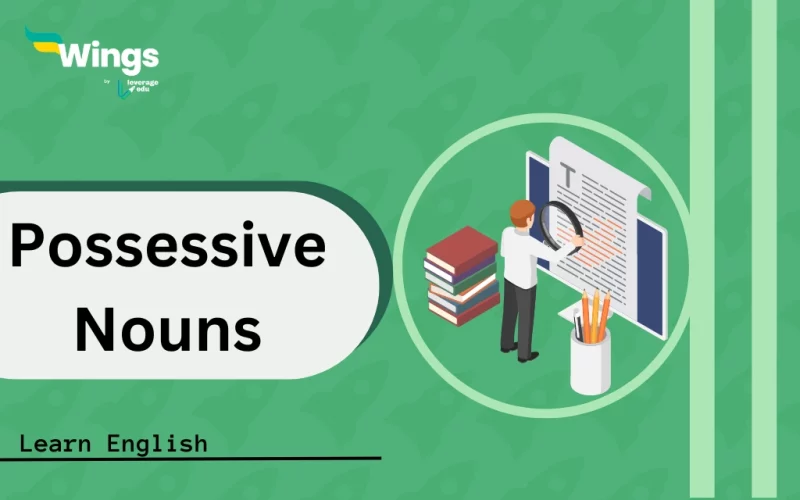Possessive Nouns, as the name suggests, indicate ownership of something. They are identified using an apostrophe (’) and an ‘s’ at the end of a singular noun. As a result, you can express relationships with things, people and ideas through this noun. With the proper usage, it indicates clear communication in the English language. To help yourself learn more about possessive nouns, you can read this blog which explains how they should be used in sentences and their examples.
This Blog Includes:
Must Read: Here’s all you need to know about Nouns
What is a Possessive Noun?
As mentioned above, a possessive noun, which is considered to be a special form of noun is used in the English vocabulary to indicate ownership (possession of something). In this noun, the owner of something (possessor) comes right before the possessive noun (what they own).
Example: Andrew’s car
If you look at the example mentioned above, you’ll notice how an apostrophe (’) and ‘s’ are there at the end of the noun. This noun is indicated by the usage of apostrophe and ‘s’.
Keep in mind that possessive nouns don’t always indicate literal ownership. (Example: Peter’s brother). On the contrary, this indicates that Peter doesn’t own his brother; rather he has a relationship with his brother.
Look at the following examples of possessive nouns:
- My house’s window is open.
- This is Thor’s room.
- The first noise I hear in the morning is that of the rooster’s crowing.
Quick Read: Possessive Adjective
How to Use Possessive Nouns?
As indicated above, possessive nouns, when used in a sentence can be identified with an ‘apostrophe’ and ‘s’. However, there are some basic rules which need to be kept in mind while incorporating possessive nouns in sentences.
Singular Possessive Noun Rules
You can make a singular noun into a possessive noun by simply adding an apostrophe or ‘s’ at the end of the noun, as the basic rule suggests.
There are exceptions as well. If the word is already ending with an ‘s’, you can add an apostrophe to make it into a possessive noun.
Examples:
- I borrowed Angel’s colour pencil.
- Harris’ working on his project right now.
Plural Possessive Noun Rules
In the case of plural nouns, you can make it into possessive nouns by simply adding an apostrophe at the end of the noun. This is to indicate ownership of something.
Example:
- The students’ test papers have been arranged as per their roll numbers.
- All the clocks’ hands have been changed.
Possessive for Multiple Nouns
If in an instance you come across multiple nouns sharing a common ownership of a particular object, make sure you add the apostrophe and ‘s’ in the last noun of the group.
Example:
- Hanzal and Ali’s parents kept looking for them till the sunset.
- Babur, Akbar and Shahjahan’s reigns were the most successful in the history of the Mughal Empire.
Hyphenated and Compound Possessive Nouns
When you are changing a hyphenated or compound noun into a possessive noun, see that you add – an apostrophe and an ‘s’ either at the end of the compound word or the latter.
Example:
- Nobody is in support of the Union Bank’s new policy which will implemented from tomorrow.
- My brother-in-law’s uncle moved to Chicago.
Possessive Nouns Examples
Following are some examples of possessive nouns which will give a much clearer understanding of all the rules discussed above.
- The new chef’s dish is a hit.
- Nina’s old house looks like a royal castle.
- Isn’t she Sanidhya’s old roommate?
- My mother-in-law’s brother got divorced yesterday.
- Nobody could find the child’s toys.
Quiz Yourself
Time to quiz yourself! Complete the following questions with the correct possessive noun.
- The other _________ shouts made them nervous as they tried to find more clues. (Students/Student’s/Students’)
- What is the plural possessive form of ‘immigrants’?
- What is the plural possessive form of ‘meadow’?
- What is the plural possessive form of ‘child’?
- What will be the plural possessive form of ‘bat’?
Check Your Answers!
- Students’
- Immigrants’
- Meadows’
- Childrens’
- Bats’
Check Related Blogs!
| Types of Nouns | Noun, Verb, Adjective, & Adverb |
| Compound Nouns | How to Use Nouns and Prepositions |
| Collective Nouns: | Plural Nouns |
| Countable and Uncountable Nouns | Abstract Noun |
FAQs
A possessive noun shows ownership of an object. They are created by adding an apostrophe or ‘s’ at the end of a noun.
Aeroplanes’ wings, Babies’ rash, Bathrooms’ taps, Ankles’, Alarms’
One of the most basic rules for possessive nouns is that the singular noun ends with an apostrophe and a ‘s’.
To advance your grammar knowledge and read more informative blogs, check out our Learn English page and don’t forget to follow Leverage Edu.
 One app for all your study abroad needs
One app for all your study abroad needs














 45,000+ students realised their study abroad dream with us. Take the first step today.
45,000+ students realised their study abroad dream with us. Take the first step today.
